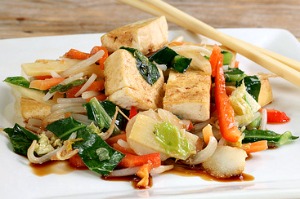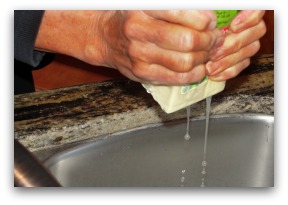How to Cook Tofu that Tastes Great?
"Prep" It First!
Now and then, people ask me how to cook tofu—because they can't understand why it doesn't taste better when they cook it themselves. And I can sympathize, because even tofu in specialty restaurants used to be more than I could stand myself. Yet it can do a lot for our nutrition and mealtime pleasure.

So, here's some good news. Besides packing roughly 10 grams of protein
into a half-cup, tofu also tastes great to many of us when
"prepped" before adding to recipes. Two simple ways to do this are by pressing and with the "freeze-and-squeeze" method.
If you give one of these a try, you may find yourself liking tofu better than you thought you did. And that can be a useful discovery for a vegetarian.
Pressing
Some people press their tofu first—compressing it into a dense (and drier) cake. In this form, the tofu can absorb more liquid from either cooking or marinating, both of which give it more taste. If I'm in a hurry, I sometimes use the EZ Tofu Press myself and find that it works pretty well. (Saves a lot of paper towels, too.)
Another Way To Press Tofu
You can also do it this way, sans press.
First, cut your tofu block into three or four equal chunks. Lay each
slice on some paper towels or, even better, a thick, clean tea towel
lying on a flat surface. Cover with another layer of towel(s) and top
it all with a cookie sheet.
Then place a weight of some kind on the cookie
sheet—a book or two, perhaps, or some heavy cans equally spaced. (But
not so heavy as to squash your tofu!) Let the tofu rest this way for 30 to 40
minutes and then unwrap the chunks. At that point, they should cook up pretty well. You can also refrigerate the pressed tofu, but for not much more than one or two days.
Freeze and Squeeze

Another method (and my own favorite) is "freeze-and-squeeze," which can change your entire experience of tofu. It does this by yielding a firm and somewhat spongy product, with minimal liquid remaining.
The only real downside to this little trick is the time you'll need to factor in for freezing and thawing the block...although you can use hot water or the microwave to speed things up in a pinch.
How To Do It
After freezing the tofu in its original package, thaw the block completely. Then cut out one side of the package (if your tofu isn't packaged in a hard container), squeezing the tofu gently over the sink. Continue squeezing until no more liquid remains.
If your tofu comes in a hard container, remove it completely after thawing. Cut it carefully into two blocks, and squeeze as much liquid as you can from each.
At that point, your tofu will have a somewhat spongy texture that you may find more to your taste. Moreover, it will now absorb more flavors than if it retained the original liquid. Crumble or cut the tofu into pieces and then sauté it, braise it in a small amount of sauce, or toss it into soups or sauces as is.
Please note: unless your tofu is extra firm, freeze-and-squeeze may not work as well as pressing.
By performing these steps beforehand and then freezing the
cooked tofu, you'll have a ready supply to add to soups, salads, pastas,
and other yummy vegetarian dishes. (In other words, slick and handy: pillars of Flex Mode.)

And speaking of "yummy vegetarian dishes," try this hearty soup, which combines tofu with kale and barley. Tasty, filling, and also great for you. But—after you eat those yummy tofu dishes, please be sure to brush and floss. Alas no, not a joke: soy products can cling to the teeth and cause mischief. So please brush and floss after any meal containing soy, which seems a relatively small price to pay...
Please understand that the material at this site is NOT medical advice, as I am neither doctor nor nutritionist. What I am is merely someone who's lived successfully on a vegetarian diet for many decades...and I transitioned from omnivore to vegetarian gradually. Do check with your doctor, though, if you're considering big changes to your own diet. Also, be sure to find a dependable source of Vitamin B12.
Living Vegetarian the Easy Way
Copyright 2010-2024. Lynda Edwards. All rights reserved.



